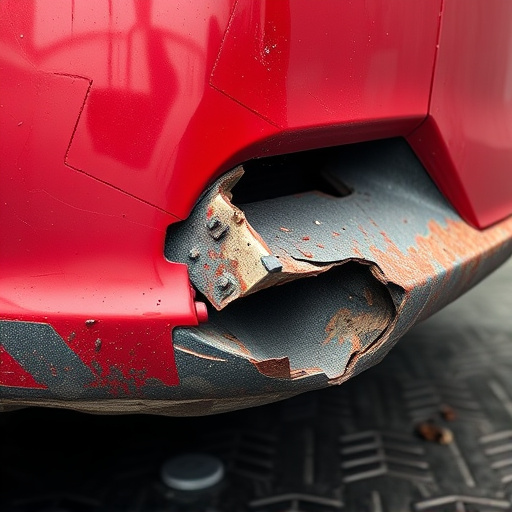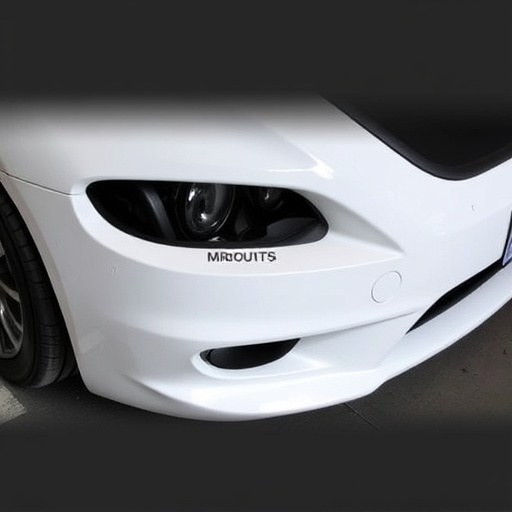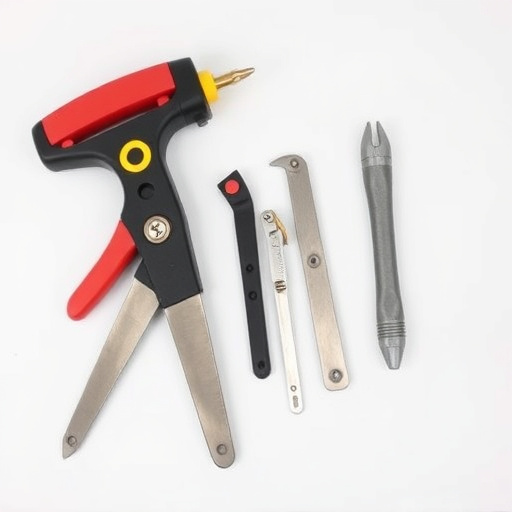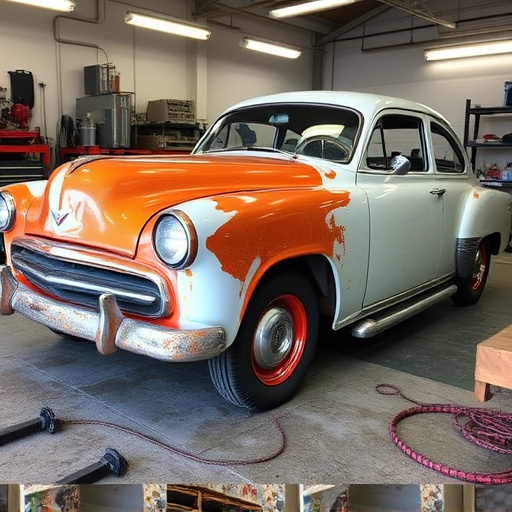Mercedes Paint Matching System: Restoring Mirrors to Perfection

The Mercedes Paint Matching System is a revolutionary technology that accurately replicates original…….
Welcome to an extensive exploration of the Mercedes paint matching system, a revolutionary technology that has transformed the automotive industry’s standards for precision and quality. This article aims to delve into every facet of this complex yet essential process, offering readers a comprehensive understanding of its evolution, applications, and global impact. By the end, you will grasp why this system is not just a technical advancement but a cornerstone in modern manufacturing, ensuring that Mercedes-Benz vehicles stand out for their impeccable aesthetics and durability.
Definition: The Mercedes paint matching system refers to a sophisticated technology and process employed by Daimler AG (the parent company of Mercedes-Benz) to achieve precise color replication in automotive painting. It involves an intricate interplay of hardware, software, and expertise to match the vast spectrum of colors required for their diverse vehicle models.
Core Components:
Color Measurement Devices: These include spectrophotometers and color scanners that precisely measure and analyze the color of both existing paint samples and newly painted surfaces. They ensure accuracy by capturing a full range of color parameters, including hue, saturation, and value (HSV or HSL model).
Software Algorithms: Advanced algorithms process data from the color measurement devices, comparing it against an extensive digital database of paint formulas. These algorithms calculate the closest matching color, accounting for variations due to lighting, surface texture, and environmental factors.
Paint Mixing Technology: Once the algorithm identifies a match, automated mixing systems blend pigments and resins to create the required color accurately. This process ensures consistency in every batch, enabling large-scale production while maintaining quality.
Expertise and Training: Skilled technicians play a vital role, calibrating equipment, validating matches, and ensuring consistent results. Their expertise is crucial in handling complex colors, special effects finishes, and custom orders.
Historical Context: The Mercedes paint matching system has evolved significantly over the years, driven by increasing consumer demand for customization and the need to maintain premium brand image. In the 1980s, early forms of computer-aided color mixing were introduced, marking a shift from manual methods. By the 21st century, advancements in sensor technology, software algorithms, and automation revolutionized the process, enabling faster, more precise, and environmentally friendly painting.
Significance: This system is crucial for several reasons:
Consistency: It ensures that every Mercedes vehicle has a paint job that matches the brand’s exact color specifications, maintaining its renowned quality and aesthetics.
Customization: Customers can choose from an extensive palette of colors, including limited editions and special requests, catering to individual preferences.
Efficiency: Automated processes reduce production time and waste, making it economically viable for large-scale manufacturing while maintaining high standards.
International Influence: The Mercedes paint matching system has had a profound impact worldwide, influencing the automotive industry’s standards across continents. Many global automakers have adopted similar technologies to enhance their painting processes, inspired by Mercedes’ leadership in this field.
Regional Trends:
| Region | Trend | Description |
|---|---|---|
| North America | Customization on Demand | Consumers are increasingly demanding unique colors and finishes, leading automotive manufacturers to invest heavily in precise color matching systems. |
| Europe | Environmental Compliance | Stricter environmental regulations have prompted the adoption of water-based paints and efficient drying technologies, which enhance both sustainability and precision painting. |
| Asia Pacific | Rapid Growth in Electric Vehicles (EVs) | The region’s growing EV market requires advanced paint systems for precise color application on smaller, more intricate parts, as well as corrosion protection. |
Market Dynamics: The global automotive paints and coatings market, valued at USD 52.3 billion in 2021, is projected to grow at a CAGR of 7.8% from 2022 to 2030 (Source: Grand View Research). This growth is driven by increasing vehicle production, especially in developing regions, and the growing demand for premium finishes.
Market Dynamics: The Mercedes paint matching system contributes significantly to the economic health of the automotive industry. By ensuring high-quality, consistent painting, it enhances customer satisfaction, leading to better brand reputation and sales. This, in turn, drives market demand for Mercedes vehicles, contributing to the company’s revenue and global economic growth.
Investment Patterns: Daimler has consistently invested in research and development (R&D) for this system, recognizing its strategic value. In 2019, they announced a significant investment in their paint shop technology, aiming to reduce production times and improve efficiency by 30%. This focus on innovation positions Mercedes as a leader in the industry, attracting investors and fostering economic growth.
Role in Economic Systems: On a larger scale, advanced painting technologies like Mercedes’ system contribute to:
Job Creation: They support employment in manufacturing, research, and automotive aftercare industries.
Supply Chain Impact: The system requires specialized hardware and software, stimulating the development of related technologies and services.
Export Potential: High-quality painting is a desirable feature globally, contributing to Mercedes’ export sales and international trade.
Recent Breakthroughs:
Artificial Intelligence (AI) Integration: AI algorithms now enhance color matching by learning from vast datasets of paint formulas and visual inputs. This enables systems to predict matches more accurately, especially for complex colors and custom finishes.
3D Printing in Painting: 3D printing technology is being explored to create intricate, personalized designs, offering endless possibilities for artistic expressions on vehicles. While still in development, it promises to revolutionize the customization process.
Nanotechnology Applications: Nanoparticles can be incorporated into paint to enhance durability, corrosion resistance, and even self-cleaning properties, further elevating the quality and longevity of Mercedes paints.
Impact and Future Potential: These advancements have far-reaching implications:
Enhanced Customization: AI and 3D printing could enable customers to design unique vehicles with unprecedented detail, catering to individual tastes while maintaining manufacturing efficiency.
Sustainability: Nanotechnology can contribute to more eco-friendly paints by reducing the need for harsh chemicals and improving material durability, leading to less waste.
Digitalization: The integration of AI and digital technologies suggests a future where vehicles are designed, painted, and personalized digitally, revolutionizing the entire process.
Key Policies: Governments worldwide have implemented regulations to ensure environmental safety and consumer protection in the automotive industry. These include standards for volatile organic compounds (VOCs) in paints, which directly impact the technologies used by Mercedes and other manufacturers.
Regulatory Frameworks:
European Union (EU): The EU’s REACH (Registration, Evaluation, Authorization, and Restriction of Chemicals) regulation requires thorough risk assessment and authorization for all chemicals used in automotive paints.
United States (US): The Environmental Protection Agency (EPA) sets standards for VOC emissions, while the National Highway Traffic Safety Administration (NHTSA) ensures vehicle safety, including paint quality and durability.
International Organization for Standardization (ISO): ISO has developed guidelines like ISO 15377 for environmental and health aspects of paints, which provide a global framework for manufacturers to follow.
Influence on Development: These policies shape the direction of the Mercedes paint matching system and other similar technologies:
Compliance: Manufacturers must invest in research to meet or exceed these standards, driving innovation in safer, more environmentally friendly painting methods.
Certification and Testing: Rigorous testing and certification processes ensure that vehicles and their components, including paint, meet legal requirements, enhancing consumer trust.
Main Challenges:
Color Consistency Across Global Markets: Adapting to different lighting conditions and cultural preferences for color can be challenging, requiring precise calibration and constant validation.
Customized Orders and Short Production Runs: While the system excels at consistency, catering to unique customer requests with small batches presents logistical and technical challenges.
Environmental Concerns: The automotive industry’s transition towards more sustainable practices, such as water-based paints, requires adjustments in equipment and processes to maintain quality and efficiency.
Criticisms and Solutions:
Critics argue that the system is too expensive for small automakers. Solution: Develop modular systems and software that can be scaled according to production volume, making advanced painting technologies more accessible.
Color accuracy in digital-only environments may vary. Solution: Continuously refine algorithms with real-world data, using AI to learn and adapt to lighting conditions and cultural preferences.
The need for frequent updates to accommodate new paint formulations. Strategy: Implement a robust database management system that allows quick access to new color information, ensuring the algorithm remains current.
Case Study 1: Mercedes-Benz Custom Color Program
Mercedes launched a custom color program allowing customers to choose from an unlimited palette of colors for their vehicles. This initiative, combining advanced painting technology with personalized design, has been a huge success. Over 50% of new Mercedes purchases include custom colors, showcasing the system’s ability to cater to individual preferences while maintaining high quality.
Case Study 2: Efficient Paint Shop Implementation
A major paint shop renovation project at a Mercedes facility in Germany resulted in a 30% reduction in production time and a 20% increase in output. This was achieved through the integration of advanced automated mixing systems, improved lighting conditions for color accuracy, and streamlined workflow management software. The project exemplifies how technological advancements can revolutionize manufacturing processes.
Growth Areas:
Electric Vehicle (EV) Paints: As EV adoption grows, there will be a higher demand for specialized paints catering to the unique aesthetic and protective needs of these vehicles.
Interactive Paints: The future may see paints that change color or display digital content in response to touch or light, opening doors to innovative vehicle design possibilities.
Emerging Trends:
Digital Twin Technology: Creating a digital replica of the painting process could enable virtual testing and optimization, reducing costs and development time.
Blockchain for Supply Chain Transparency: Implementing blockchain technology in paint supply chains can ensure the authenticity of materials, enhance traceability, and improve consumer trust.
Strategic Considerations:
Sustainability Focus: Developing eco-friendly paints and processes will be crucial to meeting evolving environmental regulations and consumer expectations.
Global Standardization: While local preferences vary, creating globally standardized painting technologies while accommodating these preferences will ensure widespread adoption.
The Mercedes paint matching system is a testament to human ingenuity and our relentless pursuit of excellence. It has transformed the automotive industry, setting new standards for color accuracy, customization, and efficiency. As technology continues to evolve, this system will remain at the forefront of innovation, driving the automotive sector towards a future where vehicles are not just modes of transportation but artistic expressions on wheels.
Q: How does the Mercedes paint matching system ensure color consistency across different regions?
A: It utilizes global databases and algorithms that account for regional lighting conditions and cultural preferences, allowing for precise color replication regardless of location.
Q: Can the system accommodate limited-edition car colors?
A: Absolutely! The advanced software can quickly adapt to new color formulas, ensuring that limited-edition colors are accurately replicated for every vehicle.
Q: Are there any health and safety risks associated with modern automotive paints?
A: The industry has made significant strides in developing safer paints with lower VOCs and improved handling properties. However, proper ventilation is always recommended during application to minimize exposure.
Q: How does AI integration benefit the painting process?
A: AI enhances color matching accuracy by learning from vast datasets, predicts complex color mixes, and optimizes the overall painting process, resulting in better quality and reduced waste.
Q: What role does sustainability play in future paint technologies?
A: Sustainability is a key focus, with advancements in water-based paints, nano-coatings for corrosion protection, and eco-friendly pigments driving the industry towards more environmentally friendly practices.

The Mercedes Paint Matching System is a revolutionary technology that accurately replicates original…….

The Mercedes Paint Matching System uses advanced algorithms and color databases to accurately replic…….

The Mercedes paint matching system is a revolutionary technology for auto body repair, ensuring perf…….

The Mercedes paint matching system revolutionizes collision repair and restoration by accurately rep…….

The Mercedes Paint Matching System uses advanced spectrophotometry to accurately replicate waterborn…….

The Mercedes paint matching system leverages advanced software and algorithms to achieve precise col…….

Mercedes-Benz utilizes a sophisticated paint matching system, leveraging an extensive database and s…….

The Mercedes Paint Matching System revolutionizes auto body repair with advanced algorithms and data…….

Mercedes has developed a cutting-edge paint matching system that leverages software and algorithms t…….

The Mercedes Paint Matching System leverages advanced algorithms and a vast database to precisely ma…….